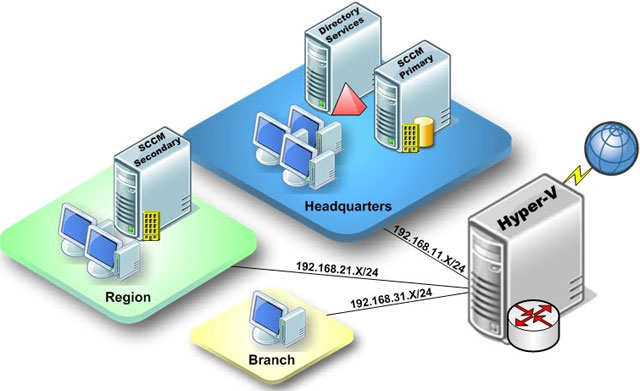Set up virtualization server
Virtualization makes managing simple as well as reducing costs. The article will show you how to choose the server and software for virtualization.
By using a physical server to run multiple virtualization servers, you can greatly reduce operating costs as well as investment costs.

Currently, it is almost impossible to buy servers that are not multi-core but many small businesses (less than 100 employees) require servers not to be so strong. However, if complying with the above requirements, it is likely that small businesses will be equipped with physical servers that are both expensive and less efficient and consume a lot of energy and radiate much heat. That's why buying multi-core servers - with 4, 6 or even 12 cores on a processor - to store virtualization servers, is suitable for all sizes of business operations.
Select the host
Decide the virtualization server success in a smaller-scale environment starting with the physical host (host). Although it will be responsible for storing dozens of virtual servers, it requires less processor resources (CPU) than you think.
Depending on the virtualization software (such as hypervisor), you will be able to run the virtualization server on a 4 or 6 core CPU. The reason is that most virtualization servers are operated almost in a maintenance state (idle) most of the time. When virtualization servers start running, their resources tend to be divided by CPU, RAM, hard disk and I / O network access, in which only a few virtual servers require significant CPU resources. By taking advantage of this, you can closely coordinate multiple physical servers on the same single server.
However, for database servers, many data downloads are not appropriate to install on the virtualization server. It all depends on hardware resources on the host server, virtualization software features, and also depending on the rules of the virtualization server. Setting up and testing these requirements before implementation is not too difficult.
Choose hardware, a rule to remember is to choose multi-core CPU and have a high clock rate for host; If you choose between a 4.93GHz 4-core CPU and a 2.4 or 12-core 6-GHz CPU, you should choose a 6 or 12-core CPU. Because of faster virtual server load sharing on multi-core CPUs, performance is more synchronized across all virtual servers.
RAM and hard disk
Virtual storage servers can always use a lot of system memory (RAM), so equip as much RAM as possible, and choose the fastest RAM possible. On the other hand, RAM allocation is much more restrictive than CPU. The more RAM you have, the more virtualization servers you can have.
In a smaller environment, you may not need storage networks or storage devices over the network to store virtualized server images, because the server will be responsible for this work. In that case, the more hard disks the better. As a general requirement, SATA drives running RAID 5 or RAID 6 are sufficient, although SAS (Serial Attached SCSI) hard drives provide more efficient performance.
Virtualization software
You have many free software options. VMware Server is free to run on Windows or Linux. Virtualization software needs an operating system to provide key requirements for operation and they are easy to install and use. If you want to completely free, install Linux on the server and run VMware Server version on Linux. If not, install Windows Server 2003 or 2008 and run the VMware Server version on Windows.
VMware has a free version of VMware ESXi. This version is built on a stable, paid version of VMware, but VMware ESXi has a number of hardware compatibility issues, hardware compatibility tests at finder.
Microsoft's Hyper-V is probably good for Windows-based networks. Technically, Hyper-V is not free, because it requires Windows Server 2008 R2, but Hyper-V has a simple interface and integrates well into the operating system. If the virtualization server runs on a Windows Server 2008 host, you can think about buying a license. Buying Windows Server 2008 R2 allows you to run four virtual Windows Server 2008 servers, with only one license.
You can also choose other options, such as Citrix's XenServer. This free version has features that may not be the free version of VMware, such as managing multiple servers. XenServer does not follow the trend like other software, but it can download and install for free, and does not need to rely on any operating system or operating system license.
Network card
In many cases, the physical server uses only 1 or 2 network cards to support the entire virtualization environment, but if the network switch (switch) allows you to route the connection to increase the bandwidth of the virtual server It is very good. Combining two or more gigabit network cards, helps you create a larger virtual network card, supports more bandwidth for users and other physical servers on the network. Many midrange switches support this feature.
If the network switch lacks the connection feature, you can set aside a network card for the most loaded server. Gigabit network cards are also quite cheap now, so equip at least four gigabit network cards for physical servers.
Electricity supply
You often find that some servers have only one power supply, but if you run multiple virtualization servers on one host, you should invest more power running redundant mode. All of your virtual servers depend entirely on the physical power supply of the physical server. The supply of backup power is quite valuable if you have a spare.
 Search file format exactly by Google
Search file format exactly by Google Save time through hotkey, macros and mouse gestures
Save time through hotkey, macros and mouse gestures 4 free Firefox utilities are very useful for businesses
4 free Firefox utilities are very useful for businesses Who is ThunderBolt for?
Who is ThunderBolt for? Image resolution - the deciding factor for fine print
Image resolution - the deciding factor for fine print New generation wireless initiatives
New generation wireless initiatives